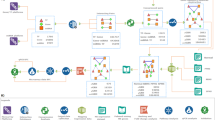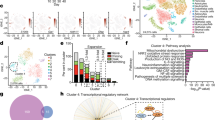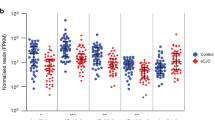Abstract
Several hundred microRNAs (miRNAs) fine-tune the expression of approximately half of all human genes. Recent studies have revealed that miRNA profiles in blood cells become altered in multiple sclerosis (MS), and that active and inactive MS lesions have distinct miRNA expression patterns. The dysregulated miRNAs in MS lesions seem to be associated with astrocytes and infiltrating immune cells, and might unleash local macrophages through downregulation of the self-recognition signal CD47. The expression of miRNA-326 in blood cells has been reported to increase during relapses. This miRNA promotes T helper 17 cell differentiation and is highly abundant in active MS lesions. miRNAs are needed for maintenance of the myelin sheath, and the absence of such molecules results in axonal damage in mice. miRNA-219 and other miRNAs promote oligodendrocyte differentiation. Here, we discuss the possible contribution of miRNAs to MS pathogenesis. An improved understanding of this contribution should help to identify novel therapeutic targets and biomarkers for this disease.
This is a preview of subscription content, access via your institution
Access options
Subscribe to this journal
Receive 12 print issues and online access
$209.00 per year
only $17.42 per issue
Buy this article
- Purchase on Springer Link
- Instant access to full article PDF
Prices may be subject to local taxes which are calculated during checkout
Similar content being viewed by others
References
Eulalio, A., Huntzinger, E. & Izaurralde, E. Getting to the root of miRNA-mediated gene silencing. Cell 132, 9–14 (2008).
Wu, L. & Belasco, J. G. Let me count the ways: mechanisms of gene regulation by miRNAs and siRNAs. Mol. Cell 29, 1–7 (2008).
Lewis, B. P., Burge, C. B. & Bartel, D. P. Conserved seed pairing, often flanked by adenosines, indicates that thousands of human genes are microRNA targets. Cell 120, 15–20 (2005).
Coolen, M. & Bally-Cuif, L. MicroRNAs in brain development and physiology. Curr. Opin. Neurobiol. 19, 461–470 (2009).
Kosik, K. S. The neuronal microRNA system. Nat. Rev. Neurosci. 7, 911–920 (2006).
Lau, P. et al. Identification of dynamically regulated microRNA and mRNA networks in developing oligodendrocytes. J. Neurosci. 28, 11720–11730 (2008).
Junker, A. et al. MicroRNA profiling of multiple sclerosis lesions identifies modulators of the regulatory protein CD47. Brain 132, 3342–3352 (2009).
Nicoloso, M. S. & Calin, G. A. MicroRNA involvement in brain tumors: from bench to bedside. Brain Pathol. 18, 122–129 (2008).
Eacker, S. M., Dawson, T. M. & Dawson, V. L. Understanding microRNAs in neurodegeneration. Nat. Rev. Neurosci. 10, 837–841 (2009).
Hebert, S. S. & De Strooper, B. Alterations of the microRNA network cause neurodegenerative disease. Trends Neurosci. 32, 199–206 (2009).
Abelson, J. F. et al. Sequence variants in SLITRK1 are associated with Tourette's syndrome. Science 310, 317–320 (2005).
Liston, A., Lu, L. F., O'Carroll, D., Tarakhovsky, A. & Rudensky, A. Y. Dicer-dependent microRNA pathway safeguards regulatory T cell function. J. Exp. Med. 205, 1993–2004 (2008).
Zhou, X. et al. Selective miRNA disruption in T reg cells leads to uncontrolled autoimmunity. J. Exp. Med. 205, 1983–1991 (2008).
Czech, M. P. MicroRNAs as therapeutic targets. N. Engl. J. Med. 354, 1194–1195 (2006).
Elmen, J. et al. LNA-mediated microRNA silencing in non-human primates. Nature 452, 896–899 (2008).
Peterson, J. W., Bo, L., Mork, S., Chang, A. & Trapp, B. D. Transected neurites, apoptotic neurons, and reduced inflammation in cortical multiple sclerosis lesions. Ann. Neurol. 50, 389–400 (2001).
Stadelmann, C., Albert, M., Wegner, C. & Bruck, W. Cortical pathology in multiple sclerosis. Curr. Opin. Neurol. 21, 229–234 (2008).
O'Connell, R. M., Rao, D. S., Chaudhuri, A. A. & Baltimore, D. Physiological and pathological roles for microRNAs in the immune system. Nat. Rev. Immunol. 10, 111–122 (2010).
Oldenborg, P. A. et al. Role of CD47 as a marker of self on red blood cells. Science 288, 2051–2054 (2000).
Yamao, T. et al. Negative regulation of platelet clearance and of the macrophage phagocytic response by the transmembrane glycoprotein SHPS-1. J. Biol. Chem. 277, 39833–39839 (2002).
Koning, N., Bo, L., Hoek, R. M. & Huitinga, I. Downregulation of macrophage inhibitory molecules in multiple sclerosis lesions. Ann. Neurol. 62, 504–514 (2007).
Du, C. et al. MicroRNA miR-326 regulates TH-17 differentiation and is associated with the pathogenesis of multiple sclerosis. Nat. Immunol. 10, 1252–1259 (2009).
Keller, A. et al. Multiple sclerosis: microRNA expression profiles accurately differentiate patients with relapsing–remitting disease from healthy controls. PLoS ONE 4, e7440 (2009).
Lindberg, R. L., Hoffmann, F., Mehling, M., Kuhle, J. & Kappos, L. Altered expression of miR-17-5p in CD4+ lymphocytes of relapsing–remitting multiple sclerosis patients. Eur. J. Immunol. 40, 888–898 (2010).
Otaegui, D. et al. Differential micro RNA expression in PBMC from multiple sclerosis patients. PLoS ONE 4, e6309 (2009).
Steinman, L. A rush to judgment on Th17. J. Exp. Med. 205, 1517–1522 (2008).
Tzartos, J. S. et al. Interleukin-17 production in central nervous system-infiltrating T cells and glial cells is associated with active disease in multiple sclerosis. Am. J. Pathol. 172, 146–155 (2008).
Dugas, J. C. et al. Dicer1 and miR-219 are required for normal oligodendrocyte differentiation and myelination. Neuron 65, 597–611 (2010).
Zhao, X. et al. MicroRNA-mediated control of oligodendrocyte differentiation. Neuron 65, 612–626 (2010).
Shin, D., Shin, J. Y., McManus, M. T., Ptácek, L. J. & Fu, Y. H. Dicer ablation in oligodendrocytes provokes neuronal impairment in mice. Ann. Neurol. 66, 843–857 (2009).
Nave, K. A. Oligodendrocytes and the “micro brake” of progenitor cell proliferation. Neuron 65, 577–579 (2010).
Kassmann, C. M. et al. Axonal loss and neuroinflammation caused by peroxisome-deficient oligodendrocytes. Nat. Genet. 39, 969–976 (2007).
Budde, H. et al. Control of oligodendroglial cell number by the miR-17-92 cluster. Development 137, 2127–2132 (2010).
Lin, S. T. & Fu, Y. H. miR-23 regulation of lamin B1 is crucial for oligodendrocyte development and myelination. Dis. Model. Mech. 2, 178–188 (2009).
Pedersen, I. M. et al. Interferon modulation of cellular microRNAs as an antiviral mechanism. Nature 449, 919–922 (2007).
Rainer, J. et al. Glucocorticoid-regulated microRNAs and mirtrons in acute lymphoblastic leukemia. Leukemia 23, 746–752 (2009).
Jackson, A. L. & Linsley, P. S. Recognizing and avoiding siRNA off-target effects for target identification and therapeutic application. Nat. Rev. Drug Discov. 9, 57–67 (2010).
Medina, P. P. & Slack, F. J. Inhibiting microRNA function in vivo. Nat. Methods 6, 37–38 (2009).
Davis, S., Lollo, B., Freier, S. & Esau, C. Improved targeting of miRNA with antisense oligonucleotides. Nucleic Acids Res. 34, 2294–2304 (2006).
Krützfeldt, J. et al. Silencing of microRNAs in vivo with 'antagomirs'. Nature 438, 685–689 (2005).
Chang, A., Tourtellotte, W. W., Rudick, R. & Trapp, B. D. Premyelinating oligodendrocytes in chronic lesions of multiple sclerosis. N. Engl. J. Med. 346, 165–173 (2002).
Kuhlmann, T. et al. Differentiation block of oligodendroglial progenitor cells as a cause for remyelination failure in chronic multiple sclerosis. Brain 131, 1749–1758 (2008).
Letzen, B. S. et al. MicroRNA expression profiling of oligodendrocyte differentiation from human embryonic stem cells. PLoS ONE 5, e10480 (2010).
Acknowledgements
The authors are supported by the Deutsche Forschungsgemeinschaft (grants SFB 571-A1 and SFB 571-C3), the Verein zur Therapieforschung für Multiple Sklerose Kranke, the Friedrich Baur Stiftung, the Hermann and Lilly Schilling Foundation, and the German Clinical Competence Network Multiple Sclerosis.
Author information
Authors and Affiliations
Contributions
A. Junker, R. Hohlfeld and E. Meinl researched the data for the article, provided substantial contributions to discussions of the content, and contributed equally to writing the article, and to reviewing and editing of the manuscript before submission.
Corresponding author
Ethics declarations
Competing interests
The authors declare no competing financial interests.
Supplementary information
Supplementary Table 1
Studies reporting changes in miRNA expression in blood or tissue from patients with MS (DOC 45 kb)
Rights and permissions
About this article
Cite this article
Junker, A., Hohlfeld, R. & Meinl, E. The emerging role of microRNAs in multiple sclerosis. Nat Rev Neurol 7, 56–59 (2011). https://doi.org/10.1038/nrneurol.2010.179
Published:
Issue Date:
DOI: https://doi.org/10.1038/nrneurol.2010.179
This article is cited by
-
Vitamins A and D Enhance the Expression of Ror-γ-Targeting miRNAs in a Mouse Model of Multiple Sclerosis
Molecular Neurobiology (2023)
-
Investigation of Relationship Between Small Noncoding RNA (sncRNA) Expression Levels and Serum Iron, Copper, and Zinc Levels in Clinical Diagnosed Multiple Sclerosis Patients
Molecular Neurobiology (2023)
-
Exosome application in treatment and diagnosis of B-cell disorders: leukemias, multiple sclerosis, and arthritis rheumatoid
Cellular & Molecular Biology Letters (2022)
-
Host miRNA and immune cell interactions: relevance in nano-therapeutics for human health
Immunologic Research (2022)
-
Choroid plexus and the blood–cerebrospinal fluid barrier in disease
Fluids and Barriers of the CNS (2020)



